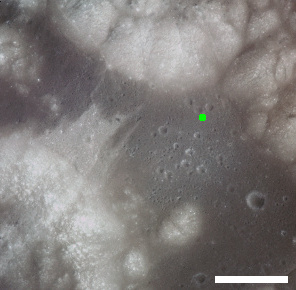Van Serg (crater)
 Location of Van Serg crater in Taurus–Littrow valley. South Massif is at lower left, North Massif is at top center, and Sculptured Hills are at upper right. Scale bar is 5 km | |
| Coordinates | 20°14′N 30°50′E / 20.23°N 30.83°ECoordinates: 20°14′N 30°50′E / 20.23°N 30.83°E |
|---|---|
| Diameter | 100 m[1] |
| Eponym | Nicholas Vanserg (pen name of ) |
Van Serg is a feature on Earth's Moon, a crater in Taurus–Littrow valley. Astronauts Eugene Cernan and Harrison Schmitt visited it in 1972, on the Apollo 17 mission, during EVA 3. Van Serg was designated Geology Station 9.
To the northwest is Shakespeare and to the northeast are Cochise and Geology Station 8 at the base of the Sculptured Hills. To the south is Sherlock, and to the southwest are the Apollo 17 landing site and the large crater Camelot.
Name[]
The crater was named by the astronauts after Harvard University geology professor , who, according to their explanation, sometimes wrote satire under the pseudonym "Nicholas Van Serg".[2] In fact, McKinstry's pseudonym was Nicholas Vanserg.[3][4] Songwriter, humorist and academic Tom Lehrer, who attended and taught at Harvard, suggested that McKinstry's pseudonym was inspired by the name of the at Harvard, which is an acronym of its original tenants: Veterans Administration, Naval Science, Electronic Research, and Graduate dining hall. Since it was a temporary building, it never got a "real" name. (This wooden building still exists.)[5] A slightly different list of tenants reported is "Veterans Administration, Naval Science, Electronic Research, and Graduate School".[6][7]




References[]
- ^ Van Serg, Gazetteer of Planetary Nomenclature, International Astronomical Union (IAU) Working Group for Planetary System Nomenclature (WGPSN)
- ^ The Valley of Taurus–Littrow, Apollo 17 Lunar Surface Journal, Corrected Transcript and Commentary Copyright 1995 by Eric M. Jones
- ^ Vanserg, Nicholas. "Mathmanship." American Scientist, vol. 46, no. 2, 1958, pp. 94A–98A. JSTOR.
- ^ William A. S. Sarjeant (1980). Geologists and the history of geology: an international bibliography from the origins to 1978. Macmillan. p. 1689. ISBN 978-0-333-29393-5.
- ^ "The College Pump - Naming Names". Archived from the original on 2010-01-16.
- ^ p. 144
- ^ Note: The full name for VA was "Veterans' Administration Guidance Center", where "Veterans' Administration" refers to the United States Veterans' Administration now known as the United States Department of Veterans Affairs. These centers were established after WWII in all major educational institutions.[1]
External links[]
- 43D1S2(25) Apollo 17 Traverses at Lunar and Planetary Institute
- Geological Investigation of the Taurus-Littrow Valley: Apollo 17 Landing Site
- LQ12 quadrangle
- Impact craters on the Moon
- Apollo 17
